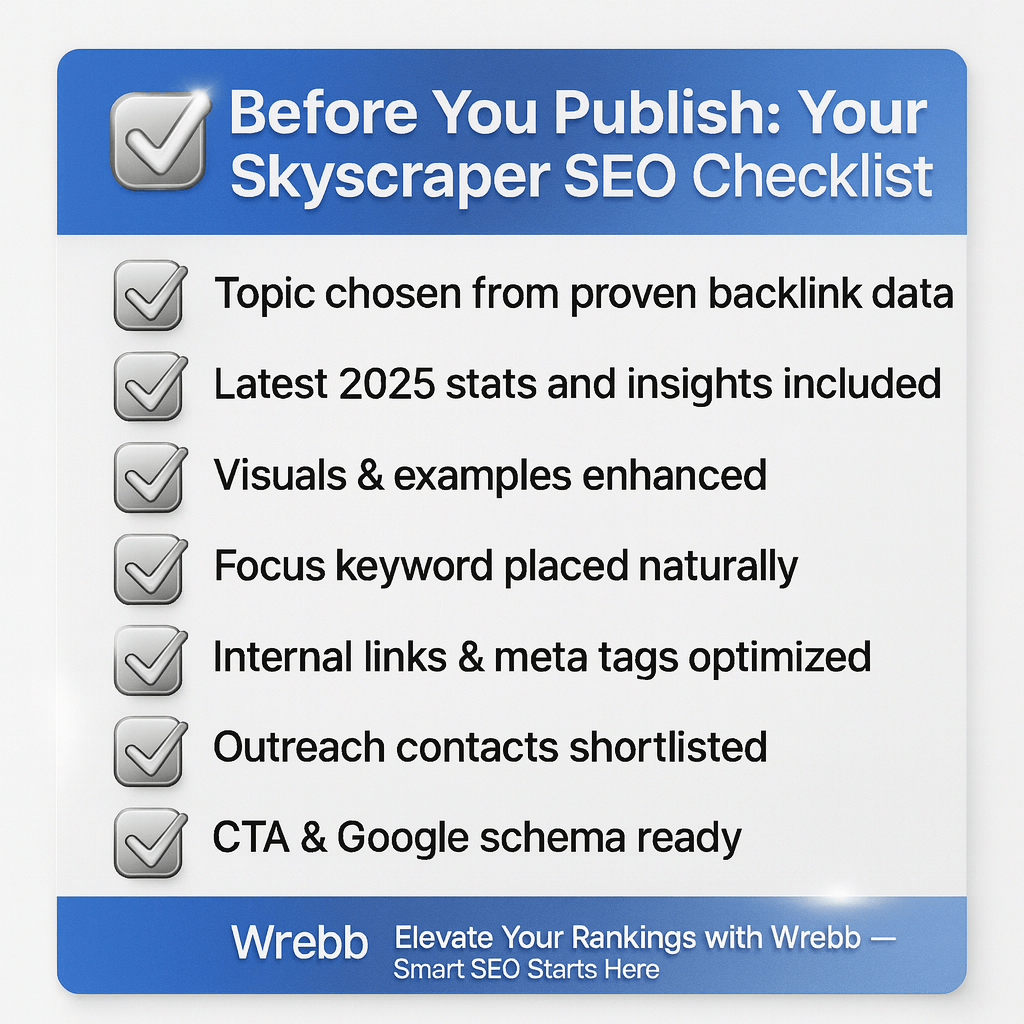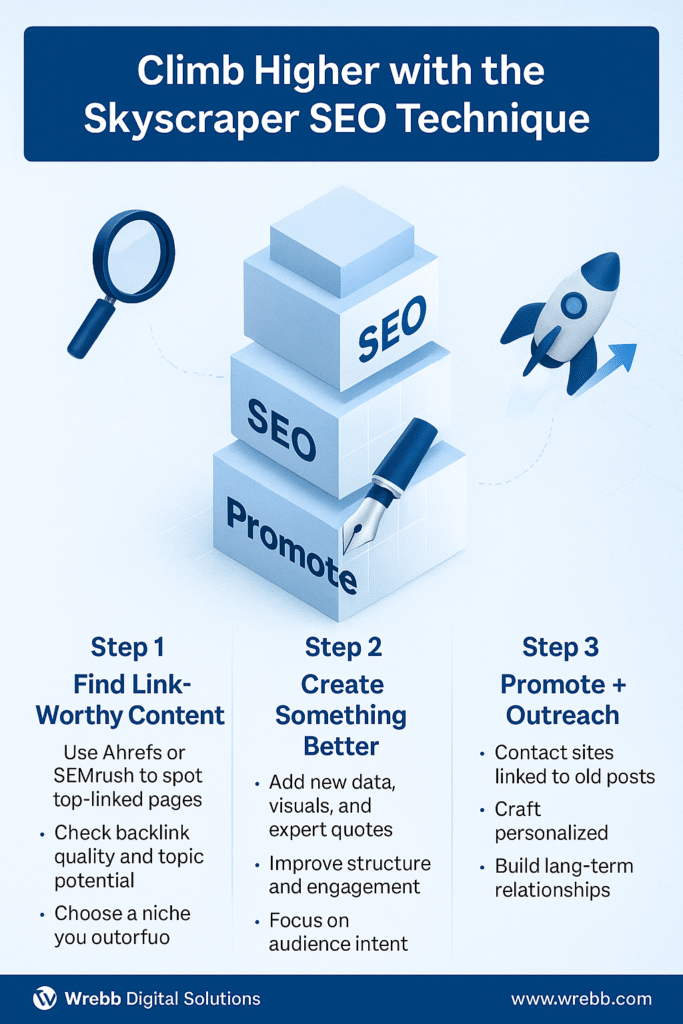The term Skyscraper SEO technique describes the process of identifying existing high-value content, then creating something even better to capture more attention, backlinks and higher rankings. In practice you look for content that already has traction, then build your version that is more comprehensive, up-to-date and link-worthy.
Table of Contents
ToggleThis approach sits under the broader idea of the Skyscraper Technique for SEO—a content plus link-building tactic popularized by Brian Dean of Backlinko.
In nutshell, you spot what is already tall in your niche, then you build a taller tower. That is your metaphor for creating content that stands out.
Why Skyscraper SEO Works So Well
When executed properly, the skyscraper SEO technique delivers for three main reasons:
- Proven demand
You are not guessing topics; you select content that already has many backlinks or social shares. That means the subject resonates. - Quality wins
People link to the best resource. If your content offers more depth, updated information or unique visuals, you increase the chance of earning links and shares. - Leverage-friendly
By reaching out to sites that linked to the original content, you save time in prospecting. Those sites already linked once; you just show them that your version is better.
Because your content becomes what we call skyscraper content, it is a long-form, authoritative resource, it carries more weight in SEO, especially in competitive niches.
This proves that landscape has changed. Some say the tactic is less effective than it once was because of overuse and algorithm shifts.
If you adapt and raise the bar, you still win.
Step-by-Step Process to Build Skyscraper Content
Here’s an expanded breakdown for using the skyscraper technique for SEO in your content marketing.
Step 1 – Identify Link-Worthy Content
- Use tools like Ahrefs (“Best by backlinks”, “Content Explorer”) or SEMrush (“Backlink Analytics”) to find pages in your niche with many referring domains. Ahrefs
- Filter for content that:
- Addresses your topic or keyword set.
- Has age (so backlinks have matured).
- Has a topic you can realistically outrank.
- Record metrics: number of backlinks, referring domains, content length, freshness, visuals, comments/shares.
- Example: In real estate, a piece might have 1,200 referring domains. That signals strong interest and gives you a target. seoClarity
Step 2 – Create Something Better
Your new content must out-perform the original in meaningful ways. Consider these enhancements:
- More comprehensive: cover more angles, answer more user questions.
- Fresh data: update statistics, include original research or case studies.
- Better visuals: diagrams, infographics, interactive elements.
- Better readability & UX: improved structure, mobile-friendly, scannable headings.
- Unique take: add expert commentary, new insights, niche-specific examples.
You are creating true skyscraper content, not just a slightly improved version.
Also remember: simply making it longer isn’t enough. It must provide more value.
Step 3 – Outreach and Promotion
Once your piece is live:
- Export the backlinks of the original piece – these are your list of prospects.
- Create personalized outreach emails emphasizing why your piece is superior and why it would benefit their audience.
- Use a friendly tone, mention specifics from their site/context, and link your new piece.
- In your outreach, avoid sounding generic; stand out.
- Continue promoting via social media, newsletters, and other channels to generate initial traction.
This outreach is the link-building leg of the skyscraper method. Without this, you might create terrific content but gain few links.

Expert Tips to Maximize the Skyscraper SEO Technique
Here are some advanced tweaks that help you get more from your “skyscraper” efforts:
- Use AI/data-mining for topic ideation. For example, combine the skyscraper method with tools like ChatGPT or custom data-sets to uncover underserved topics.
- Incorporate E-E-A-T: Experience, Expertise, Authoritativeness, Trustworthiness. These elements matter more than sheer length. Google’s algorithms reward high credibility.
- Refresh your content periodically. A skyscraper doesn’t age well if features are outdated—update stats, examples, visuals.
- Don’t ignore user signals: dwell time, bounce rate, mobile optimization, Core Web Vitals. Skyscraper content often attracts high engagement if done well.
- Build internal linking into the piece—and from the piece—to reinforce topic authority. While outreach gets external links, internal links reinforce structure.
- Use multi-format content: add video, podcast version, downloadable checklist or template. These enrich your piece and help promotion.
- Target strategic anchor links: in outreach, suggest to the prospect where in their content your new piece adds value—makes it easier for them to link.
Common Mistakes to Avoid in Skyscraper SEO
Even tried-and-tested techniques can fail if mis-applied. Here are frequent pitfalls:
- Creating very long content that’s still shallow. Length alone doesn’t guarantee value. Many SEOs mis-interpret “better” as just “longer”.
- Copying the original content with minor tweaks. If your piece doesn’t genuinely stand out, outreach will fail and users won’t engage.
- Targeting the wrong anchor sites: outreach to sites that aren’t relevant or have poor link profile. Quality over quantity.
- Making email outreach generic or spammy. Since many people use this tactic, your outreach must be personalized and compelling.
- Ignoring promotion beyond outreach. Your piece needs visibility and momentum. Even great content will flounder without push.
- Neglecting maintenance: publish the piece and leave it. Content should be audited, refreshed, updated.
- Focusing only on backlinks and ignoring onsite SEO, UX and intent matching. A holistic approach is required.
Real-World Examples of Skyscraper SEO Success
Let’s look at how this strategy has been used to win real results:
- Brian Dean’s original case: he published a post “Google’s 200 Ranking Factors” then used the skyscraper method and saw a 110% traffic increase in just 14 days.
- HubSpot reported a piece using the technique earned over 70,000 page views.
- Agencies report that while the skyscraper method has matured, when paired with strong UX and outreach it still drives authoritative links and domain authority.
These examples show that when you create standout skyscraper content and do outreach smartly, you build both traffic and authority.
Tools to Enhance Your Skyscraper SEO Workflow
Here are some essential tools to streamline the process:
- Content research / backlink analysis: Ahrefs, SEMrush, BuzzSumo. Useful for Step 1.
- Content optimisation: seoClarity (Research Grid), Clearscope, Surfer SEO. For refining your content structure.
- Outreach / link-building: Hunter.io, Respona, Pitchbox. For managing campaigns, finding contacts, sending emails.
- Performance tracking: Google Analytics, Google Search Console, backlink monitoring (Ahrefs/SEMrush). To measure results of your skyscraper campaign.
- Content formats & visuals: Canva / Adobe Illustrator for infographics, Loom for video embed, Miro for interactive visuals.
How Skyscraper SEO Fits into Your Long-Term Content Strategy
The Skyscraper Technique for SEO isn’t a one-and-done trick. It integrates into your broader content system.
- Use skyscraper pieces as pillar assets. They become anchor pages in a topic cluster.
- Use smaller content to link to and support your skyscraper pieces (cluster content).
- Maintain and refresh skyscraper content to keep it current and authoritative.
- Use skyscraper-driven backlinks to elevate new content in the future (leveraging authority).
- Over time, your brand becomes a recognized authority in your niche—skyscraper content helps build that reputation.
- This strategy also dovetails with evergreen content, topic-expert authority building, and conversion-focused content (not just traffic).
Frequently Asked Questions
What is Skyscraper SEO and why should you use it?
Skyscraper SEO is a method where you find high-performing content in your niche, create a version that is better and more valuable, then reach out to sites linking to the original to point to your improved piece. It’s effective because you’re leveraging proven interest and turning it into an asset you control.
How long does it take to see results from the Skyscraper Technique for SEO?
Results vary. Some see traction within a few weeks if outreach succeeds and backlinks start arriving. Others may take months as organic signals build. It depends on niche competitiveness, outreach quality and content quality.
Can small businesses use Skyscraper SEO successfully?
Definitely. Even if you’re a small business, if you choose a niche-specific topic, create really valuable content and do targeted outreach, you can succeed. Focus on relevance, quality and personalized outreach rather than massive scale.
Conclusion
If you want to elevate your SEO game, the Skyscraper SEO strategy remains one of the most effective content-driven techniques in digital marketing. By following the three-step process — find, build better, and outreach – you can create skyscraper-level content that attracts quality backlinks, improves rankings, and strengthens your long-term online authority.
When you’re ready to put this strategy into action, Wrebb Digital Solutions can help you plan, create, and promote powerful SEO content that truly stands out.
Partner with Wrebb Digital Solutions to build SEO content that dominates search results and drives measurable growth for your business.
Let’s start building your skyscraper today — and rise above the rest.



